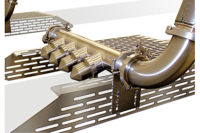
Thorough equipment tear-down a must during sanitation. Recent RFA meeting also profiled suppliers’ new cleaning chemicals.

R&FF: Foodborne illness was in the news this summer. What’s caught your attention?
Martin Mitchell: We now realize that almost any food group generates food safety concerns. It’s difficult to know where to begin with examples. As we speak, cantaloupe has a top spot in the news.
Who knows what to say? Leafy greens and other produce, meat and poultry items receive a great deal of attention – but also peanut butter and eggs? These headlines simply tell us we must re-double efforts to ensure proper refrigerated food manufacturing practices.
R&FF: What are the most important food safety steps for a cold food plant?
Mitchell: Let’s start with sanitation. Quite a few refrigerated food processors do not have a microbial kill step, so we must rely on other factors to control food safety concerns. Sanitation is important in that regard. We must have clean facilities and clean equipment. We emphasize proper cleaning and the liberal use of sanitizers. You see foot dips and floor foamers everywhere. Processors should constantly monitor these areas as part of a well designed environmental sampling program. Proper equipment construction and maintenance also are important. All too often, I don’t think equipment suppliers properly demonstrate the proper “tear down” of equipment. Thorough training helps sanitation crews do their jobs properly.
Product formulation also is critical. We recommend processors use antimicrobial ingredients, sorbates and benzoates, vinegars and other acidic ingredients. The current trend for “all natural” is a concern. If we move away from traditional preservative systems, we may not provide the storage protection we have developed and successfully relied on for maintaining a safe refrigerated food supply.
R&FF: Your reference to “storage protection” and “food supply” makes us think about thermal abuse in the cold chain. That’s important too, right?
Mitchell: Refrigeration control is extremely critical. After all, we are the “refrigerated foods industry.” We know spoilage occurs if products are not processed and transported under refrigerated conditions. More customers and manufacturers are using temperature tracing instruments to document temperature abuse in the shipping and distribution chain. Unfortunately, retailers don’t always maintain the cold chain as they should.
R&FF: How does RFA help members address food safety issues?
Mitchell: RFA’s technical committee hosts monthly conference calls where company representatives openly discuss food safety issues and share best industry practices. These conference calls are important. Depending on topics of interest, they lead us to develop webinars and they guide speaker selections for RFA’s annual meeting.
One of the most popular sessions at the 2010 annual meeting was a presentation – with a lengthy question-and-answer time – about facility sanitation and equipment design. More recently, our 2011 RFA Symposium (September in Minneapolis) provided presentations and tours focused on sanitation and related food safety issues.
Our attendees had an opportunity to see chemical suppliers’ latest compounds and related equipment for proper plant sanitation. Guest speakers demonstrated quick ATP evaluations to assure proper cleaning. They also showed us micro testing programs processors can use to make faster decisions about plant sanitation and cleanliness.
R&FF: What’s something new you’ve learned about food safety?
Mitchell: We’ve recognized that not all dry ingredients are pathogen free. Refrigerated processors know it’s important to review ingredient sources and select materials from suppliers that take food safety measures. Recent recalls teach us that it’s critical to buy spices and other dry ingredients that have received some microbiological treatment step to reduce potential contamination.
We recommend that RFA members pay more attention to spice and dry ingredient handling areas. Although Salmonella may not grow there, dry ingredients can harbor this and other bacteria.
R&FF: What food safety advances would you most like to see in 2012?
Mitchell: We understand there is no simple solution to a broad array of food safety issues. Microorganisms are everywhere – including areas in which we didn’t believe them to be of concern.
Refrigerated food processors must use every means to assure food safety. As an industry, we need to encourage antimicrobial treatment applications. At the top of the list would be acceptance of irradiation as a standard practice. The technology is proven. U.S. regulators need to recognize that we must use this technology to get ahead of the continuing evolution of pathogenic organisms.
We also need to develop a better relationship between regulators and the industry. Politics and regulations cannot control microorganisms in our food and in our plants. However, we need government and industry to work together to resolve issues – not simply attempt to regulate them.
There’s also a consumer and customer element. Consumers should take steps to help protect themselves. Bad habits in the kitchen can results in cross contamination from raw to prepared foods. Restaurants and foodservice operations know and understand proper food preparation controls. However, they also need to constantly reinforce temperature control and sanitation – their own versions of Good Manufacturing Practices – with staff members. No one in the industry wants to prepare and serve harmful products. We all must work together to increase the food safety awareness for everyone.
